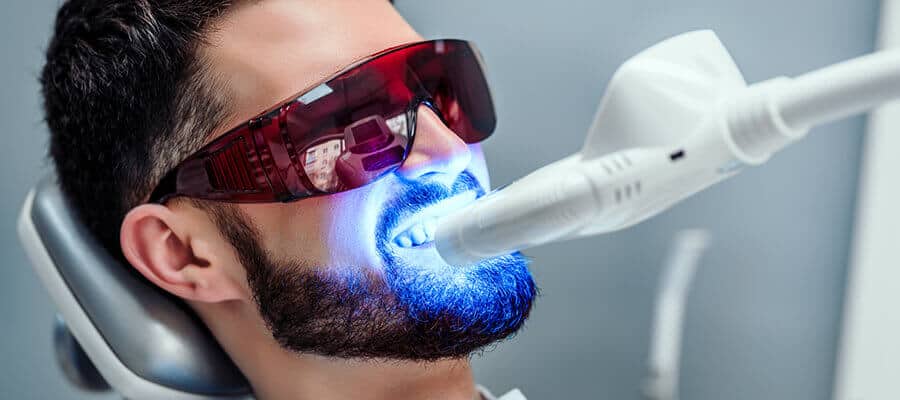
A dental bridge is a fixed (non-removable) appliance and is an excellent way to replace missing teeth.
There are several types of bridges. You and your dentist will discuss the best options for your particular case. The “traditional bridge” is the most popular type and is usually made of porcelain fused to metal. This type of bridge consists to two crowns that go over two anchoring teeth (abutment teeth) and are attached to pontics (artificial teeth), filling the gap created by one or more missing teeth.
Dental bridges are highly durable and will last many years, however they may need replacement or need to be re-cemented due to normal wear.
Reasons for a fixed bridge:
- Fill space of missing teeth.
- Maintain facial shape.
- Prevent remaining teeth from drifting out of position.
- Restore chewing and speaking ability.
- Restore your smile.
- Upgrade from a removable partial denture to a permanent dental appliance.
What does getting a fixed bridge involve?
Getting a bridge usually requires two or more visits. While the teeth are numb, the two anchoring teeth are prepared by removing a portion of enamel to allow for a crown. Next, a highly accurate impression (mold) is made which will be sent to a dental laboratory where the bridge will be fabricated. In addition, a temporary bridge will be made and worn for several weeks until your next appointment.
At the second visit, you permanent bridge will be carefully checked, adjusted, and cemented to achieve a proper fit. Occasionally your dentist may only temporarily cement the bridge, allowing your teeth and tissue time to get used to the new bridge. The new bridge will be permanently cemented at a later time.
You will receive care instructions at the conclusion of the procedure. Proper brushing, flossing and regular dental visits will aid in the life of your new permanent bridge.
FAQs
How can a dental bridge help me?

A fixed dental bridge is a type of dental restoration designed to fill the space left by one or more missing teeth. A traditional dental bridge is composed of two crowns for the teeth that neighbor the gap and a pontic (a.k.a., false tooth) to fill the space. Pontics are made of materials such as gold, alloys, porcelain, or a blend of these substances.
Who is a suitable candidate for a fixed dental bridge?
Fixed dental bridges are suitable for individuals with one or more missing teeth who wish to restore their smile, normal or near-to-normal chewing ability, and clear speech. Good candidates typically have strong teeth adjacent to the missing tooth or teeth, as these teeth act as anchors for the bridge.
What is the timeline for getting a fixed dental bridge?
The process of obtaining a fixed dental bridge generally involves two or more visits to Dr. Rader. In the initial visit, the anchor teeth are prepared by removing some enamel to accommodate the crowns. Impressions of the teeth are taken to create a model for the bridge. A temporary bridge is then placed to protect the exposed teeth and gums while the permanent bridge is being fabricated. The subsequent visit includes fitting, adjusting, and cementing the permanent bridge into place.
How should one maintain a fixed dental bridge?

Caring for a fixed dental bridge involves the following practices:
- Brushing twice a day and flossing daily, using special flossing tools to clean around the false tooth or teeth
- Regular dental check-ups and professional cleanings
- Avoiding hard foods that could damage the bridge
- Using antiseptic mouthwash to prevent tooth decay and gum disease
What is the typical lifespan of a fixed dental bridge?
With proper care, fixed dental bridges can last from 5 to 15 years, and sometimes even longer. Regular check-ups are crucial as they allow Dr. Rader to assess the fit of the bridge and the health of the anchoring teeth.
What are the advantages of fixed dental bridges?
Fixed dental bridges offer several benefits, including:
- Restoring the appearance of the smile, chewing function, and speech
- Properly distributing forces in the bite by replacing missing teeth
- Preventing remaining teeth from shifting out of position
Are there alternatives to fixed dental bridges?
Yes, alternatives to fixed dental bridges include dental implants and removable partial dentures, each with its own set of advantages and considerations. Dental implants offer a more durable solution without the need to alter adjacent teeth, but they require good bone density and are more costly. Removable partial dentures are less invasive and less expensive to place but may not be as aesthetically pleasing or as stable as bridges or implants.
What are the potential risks associated with fixed dental bridges?
While generally safe, fixed dental bridges can pose risks, including the following:
- Increased tooth sensitivity, especially after the initial placement
- Tooth decay or gum disease under the crowns if oral hygiene is neglected
- Weakening and possible structural damage to the supporting teeth, since healthy tooth enamel must be removed to accommodate the bridge
- Dislodgement of the bridge






